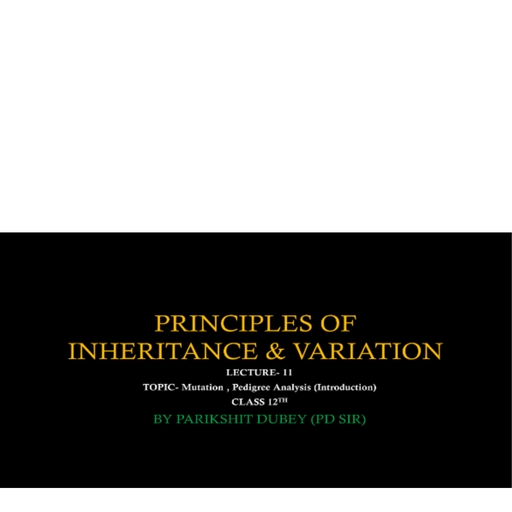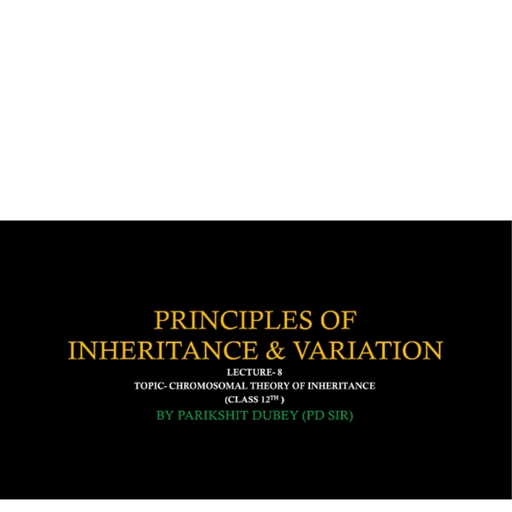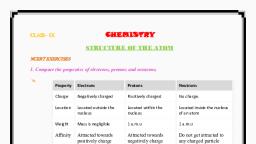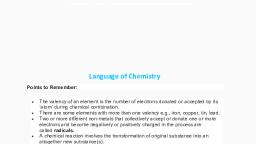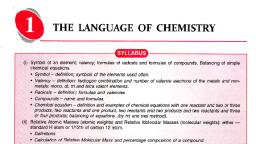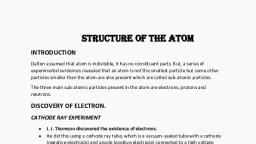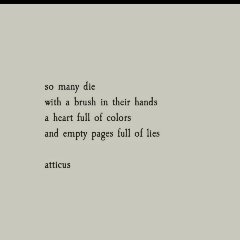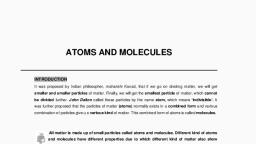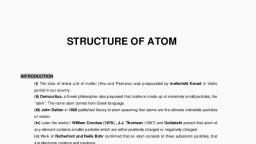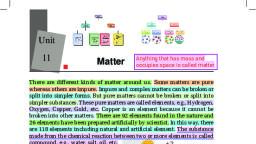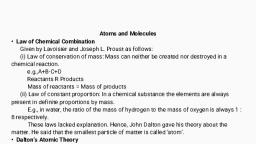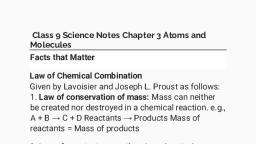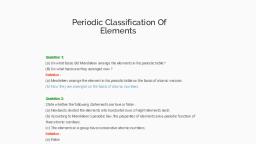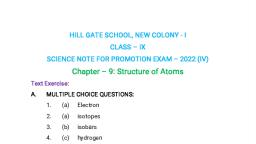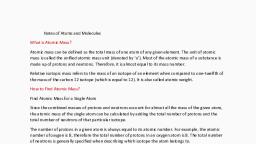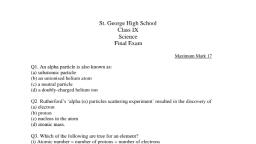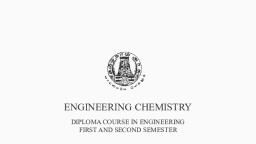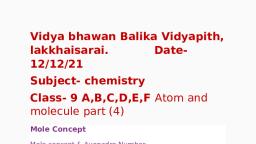Page 1 :
aleny, , , , * Symbol ~ defini, © Valency — definition: gen, , metals; mono, di, ti and teira v, * Radicals — definition; tormuiae and vai, * Compounds — name and formulae., , , , Ven, encies, , , , ‘< oe equation ~ definition and examples of chemical equations with one reactant and two or three, pi " ucts, two reactants and one product, two reactants and two products and two reactants and three, , - or four products; balancing of equations (by hit and trial method)., (ii) Relative Atomic Masses (atomic weights) and Relative Molecular Masses (molecular w, , standard H atom or 1/12th of carbon 12 atom., ¢ Definitions, , * Calculation of Relative Molecular Mass and percentage composition of a compound., , 1.1 INTRODUCTION, , Chemistry is a branch of science in which we, study about matter, ie. what is matter made up of,, what is its nature, structure and what changes are, observed when it is subjected to different conditions., , Many theories were proposed regarding matter, which helped us to discover the real essence of matter., , The basic units of matter in any state is, considered as molecules. This is because a molecule, is the smallest particle of matter which is capable of, independent existence., , A pure substance is one which is made up of, molecules containing the same kind of atoms. For, example, carbon dioxide gas is a pure substance, all, the molecules of it are made up of two oxygen atoms, and one carbon atom., , A molecule may contain similar atoms or, dissimilar atoms. A pure substance in which a, molecule is made up of atoms of the same kind is, , called an element., , An element is @ simpl, matter which cannot be decompose:, , substances., , , , , , , , 'e and pure, form of, d into simpler, , , , , , , , , nts are made of atoms, the smallest, , All eleme, particles of an element which represent all the:, , properties of an element., , , , , , f fosniiae of radicals and formulae of compounds. Balancing of simple, , , , , , , , ro, , eights): either —, , , , ‘An aiom is the smallest particle of an element, which may or may not exist independently but, can take part in a chemical reaction., , , , , , A set of atoms of the same type together forms, the molecule of the element: The number of atoms, in a molecule of an element is called its atomicity., , Molecules can be monoatomic, diatomic and, , even polyatomic., Monoatomic molecules — elements having only one, atom in their molecules. Noble gases (Helium, Neon,, Argon, Krypton, Xenon and Radon) have one atom, each in their molecules. So, the atomicity of noble, gases is one. The atomicity of metal elements like, sodium, potassium, magnesium, copper, etc. is also, taken as one. The atomicity of element carbon is also, one. Thus noble gases, metals and carbon are, monoatomic molecules., , . Diatomic molecules — elements having two atoms, , in their molecules, e.g. hydrogen (H,), Oxygen (O02),, Nitrogen (N>)., Triatomic molecules, in their molecules, e.g. ozone (O3)., , Tetratomic molecules — elements having four atoms, in their molecules, ¢.g. phosphorus (P4). a, , — elements having three atoms
Page 2 :
Octatomic molecules — elements having eight atoms, in their molecules, e.g. sulphur (Ss)., , A molecule is the smallest particle that has the, capability to exist independently. The molecule of, an element exhibits all the properties of that element., , When atoms or molecules of different elements, combine chemically in a fixed ratio, they form the, molecule of a compound. To name a few, sodium, chloride (NaCl), water (H,0). ammonia (NH3) are, , molecules of compounds., Two or more kinds of mole, mixtures. A mixture may include constituents as, , elements, an element and a compound or only, ures can be homogeneous with, which has non, , , cules combine to form, , compounds. Mixt, uniform composition or heterogeneous,, uniform distribution of the different types of molecules., , For example. salt solution is a homogeneous mixture,, whereas muddy water is a heterogeneous mixture., The names of elements and compounds are, abbreviated by using certain symbols and formulae., Before 1600 A.D., alchemists tried to represent the, substances that they used for their experiments by, different kinds of pictographic symbols, such as a, triangle [A] for the earth, a crescent {CJ for silver, etc., Dalton used some other types of symbols to represent, elements, such as a circle [O] for an oxygen atom, a, circle with a dot in its centre [o] for hydrogen, etc., , Dalton’s symbols of elements, , , , Hydrogen, Carbon, Oxygen, Phosphorus, Sulphur, Platinum, Tron, Copper, Silver, Gold, Lead, , , , 208 ©O0OS80@®@, , , , Mercury, , , , , , Later, Jons Jakob Berzelius suggested that the, initial letter of an element written in capitals should, , articular element, such as O fo,, H for hydrogen, C for carbon, and so on. Butj Rey, cases, the suggested symbol did not agree se 80mg, English name of the element. This was Decay ‘, of the symbols were based on the Latin names . Some, , language names of the elements, as shown jn Tae, lel], , However, the method suggested by him ' i, basis of the IUPAC (International Union of Punt the, Applied Chemistry) system of chemical symbol, and, formulae. S ang, , ‘Table LL: Symbols of certat, on their Latin |, , represent that p:, , , , ements hase, , Name of element Latin Name, , , , , , , , , 1. Gold Aurum, , 2, Silver Argentum, 3. Mercury Hydrargyrum, 4, Copper Cuprum, , 5. Lead Plumbum, 6. Iron Ferrum, , 7. Sodium Natrium, 8. Potassium Kalium, , 9. Tin Stannum, 10. Antimony Stibium, 11. Tungsten Wolfram |, , , , , , (German name) |, , , , 1.2 SYMBOLS, A symbol is the short form that stands for the, , atom of a specific element or the abbreviation used, for the name of an element., , Each element is denoted by a symbol, which is, usually the first letter of its name in English or Latin,, written in capital., , Example : Sulphur, an element, is denoted by, the symbol ‘S’. Similarly, hydrogen is denoted by, the symbol ‘H’., , However, when the first letter of more than oné, element is the same, the elements are denoted by, two letters. The first letter is written in capital, whil, the second one is written in small., , Example : Carbon, cobalt, copper! calciul,, cadmium, chromium, and chlorine are elements, whose first letter is C. Therefore, only carbon 8, denoted by the symbol ‘C’. Cobalt is denoted by two, letters ‘Co’. Copper is denoted by the §° jetes, ‘Cw’ [taken from its Latin name cuprum). Calciu™
Page 3 :
en, Me, the, me, her, , —, , by Ca, Cadmium by Cd, Chroimium by Cr and, , Chlorine by Cl. , Note : Be careful about, For example : Co tneans, , however, CO means the compour, A symbol is not mes! 5, , name of an element byi also ha, , , , , , , , , mor, , , , Significance of a s, It represents :, (i) Name of the clemeny, (ii) One atom of the element, (iii) A definite mass of the element (equal to, atomic mass expressed in grams)., For example, the symbol N stands for, (i) The element Nitrogen, (ii) One atom of Nitrogen, (iii) 14 grams of nitrogen. (This weight being, the atomic weight of the element)., Table 1.2 : Symbols of some common elements, , , , , , | Name in Symbol Name in Symbol, English English, , Magnesium Mg Hydrogen H, Aluminium Al Nitrogen N, Calcium Ca Oxygen oO, Chromium Cr Fluorine F, Manganese Mn Chlorine - cl, Cobalt Co Bromine Br, Nickel Ni Jodine I, Zinc Zn Carbon c, Silver Ag Sulphur Ss, Barium Ba Phosphorus P, Arsenic As Boron B, Platinum Pt Silicon Si, Uranium U Helium He, Lithium Li Neon | Ne, Germanium Ge Argon Ar, , , , , , , , , , , , , , , , , , 1.3 VALENCY, , The valency of an element is a measure of its, combining power with other elements., , Valency is measured in terms of hydrogen atoms, or oxygen atoms. It is the number of hydrogen atoms, or double the number of oxygen atoms that can, combine with it., , Since no other element has combining capacity, Jess than that of hydrogen, its valency is taken to be, , one (1) and is considered a standard., patina 3, , , , , , , , Modern Definition lency, , The number of electrons that an atom can lose,, gan or share during a cheir eaction is called its, valency, , lectrons in the outermost shell of the atom are, Koowa as valence electrons, , Au atom contains electrons, protons and neutron,, , cach electron has | unit negative charge and each proton, has | unit positive charge. Neutron has no electric, charge, it is neutral. Every atom normally contains an, equal number of electrons and protons which balance, the charges in the atom and make an atom electrically, neutral. If one or more electrons are either removed, from an atom or added to an atom, then the atom has, either Jess number of electrons than normal or more, number of electrons than normal, and it gets an overall, , electric.charge. The atom then becomes an ion., , , , , , , , An ion is a positively or negatively charged atom, (or group of atoms) which is formed by loss or, gain of electron(s) by an atom (or group of atoms). |, , , , , , The loss or gain of electrons in an atom depends, upon electron(s) in the outermost shell., , To attain stability, atoms have to have eight, electrons (attain octet) in their outermost shell., , Thus atoms with one, two or three electrons in, their valence shell lose these electron(s) to attain, stability and thus form monovalent, divalent and, trivalent positive ions respectively., , Na — e- > Nat (monovalent), 2, 8,1 2,8, Mg — 2e- > Mg?* (divalent), 2, 8,2 2,8, , Al - 3e° @ AB (trivalent), 2, 8,3 2,8, , Positive ions are known as cations., , , , , , , , Note : Elements with one, two or three electrons in, their outermost shell (valence shell) are usually, metals. Out of the elements that have four electrons, in the outermost orbit — Carbon is a non-metal, Silicon, and Germanium are metalloids and the rest are metals., Elements with five, six or seven electrons in their, outermost shell are normally non-metals., , , , , , , , Atoms with seven, six and five electrons in their, valence shel] gain one, two and three electrons, respectively in order to complete their octet and thus
Page 4 :
valent and trivalent negative, , they form, monovalent, di, , ions. (monovalent), , cl, ate?, (2,87) 2,88, 0 + 2 > OF (divalent), (2.6) 2.8, N + 3c 3 N3 (trivalent), (2, 5) 28, , Neeative ions are known as anions, [ ] | Ts] o]7]8, No. of electron(s) | V | 2 | 3 4 | 5 | 6, , {_{_+_J, , Valeney 1] 2 [3], , in outermost shell |, , , , , “Valency is the combining capacity of an atom, or of a radical., , The valency of an element or of a radical is the, number of hydrogen atoms that will combine with, or displace one atom of that element or radical., , , , Examples of sharing of atoms :, , (1) One atom of chlorine combines with, one hydrogen atom to form a molecule of, hydrogen chloride. So, the valency of chlorine, Is one., , H-Cl, Gi) One atom of oxygen combines with 2 atoms of, hydrogen to form a molecule of water, So, the, valency of oxygen is two., , oO, nH SH, (iii) In an ammonia molecule, one atom of, , nitrogen combines with 3 atoms of hydroge, n., So, the valency of nitrogen is three, mee, , 1,, , i, (iv) Ina methane molecule, one carbon atom, , combines with 4 hydrogen, atoms,, valency of carbon is four, * So. the, , jane. » yalency, Variable va ) a., 3 etl, Certain elements exhibit more than one Val, , they show variable valency., , Reasons for variable valency, An atom of an element can sometimes, , sent in; 8 log, , etrons than are present in its ale 86, , Mey,, , Le., , more cle ki : ni, , shell, ie. there is a loss of electrons frat, the penultimate shell too. Therefore, Such :, element is said to exhibit variable valency, ", , If an element exhibits two different Posit,, valencies, then we use the suffix “ous” for the long, valency and the suffix “ic” for he higher Valen,, Modern chemists use Roman nvurescrals in place oy, these trivial names. For exanple, Src, a, stannous chloride is written as fs) (If) chloride, SnCly, Le. stannic chloride is written as Tin wv,, , , , , , chloride., , Non-metals like nitrogen, phosphorus and, sulphur also show variable valency. Nitrogen did, phosphorus exhibit valencies of 3 and 5 While, sulphur exhibits valencies of 2, 4 and 6., , Table 1.3 : Examples of variable valency, , , , , , , Metal Valency Name of compound formed Formula, , , , , , , , , , Iron { 2 Ferrous [Iron (I1)] oxide FeQ, 3 Ferric [Iron (II)] oxide Fe,0,, , Copper { 1 Cuprous [Copper (1)] oxide CuO, 2 Cupric [Copper (ID] oxide Cu0, , Mercury { 1 Mercurous [Mercury (1)] oxide Hyg,0, 2 Mercuric C, , [Mercury (I1)] oxide HO, , Lead { 2 Plumbous [Lead (I)] oxide PbO, 4 Plumbic [Lead (IV)] oxide PbO, |, { 2 Stannous [Tin (11)] chloride SnCl, |, , , , Stannie [Tin QV)] chloride SnCl,, , , , 14 FORMULA, , Al ., ‘Atoms of elements combine to form molecules., , So it i, 1S possible to Tepresent the molecules in terms of, , sym| i ., ymbols of their Constituent atoms. The symbolit, , representatj Bs, H ' A tation of a molecule is known as formula or, nolecular formula, H—c_y ls, ~ A mole, cular form ical, ¥ ula t ehemica, : Sormula also known as ch, , , , elemen,, , employs symbols to denote the molecule of™, "or of a compound,
Page 5 :
elements hydrogen, oye sien hlori, bromine and iodine, contains two atoms, “, written as H>, Oo, No, Cl, Bry and I, reg . a are, In case of a compound, the ‘clean, different atoms united in a ©, represented by placing symbols of th, , in it side by side indicating, subscripts. Thus, NH,Ci repres, ammonium chloride con, four atoms of hydrogen :, NazCO3 denotes «, carbonate which conta:, atom of carbon and three, , molecule contai ing, ain fixed ratio is, , 1, , , , , , , , , , , , , , , 2H,0 represents two, , moiecules of water ie, dihydrogen oxide, each molecule containing two, atoms of hydrogen and one atom of oxygen., , Thus by looking at a formula, we understand, the ratio in which the different atoms are united to, form the molecule., , , , , , | Significance of molecular formula, The molecular formula of a compound has, , quantitative significance. It represents :, , (i) both the molecule and the molecular mass of the, compound., , (ii) the respective numbers of different atoms present in, one molecule of the compound., , (iii) the ratios of the respective masses of the elements, present in the compound., , For example, the formula CO means that:, , (i) the molecular formula of carbon dioxide is CO,;, , (ii) each molecule contains one carbon atom joined by, chemical bonds with two oxygen atoms;, , (iii) the molecular mass of carbon dioxide is 44, given, , that the atomic mass of carbon is 12 and that of, , oxygen is 16., , , , 15 RADICALS, , The molecule of, of two parts and these parts are, radicals. For example, a mol, chloride has two parts, potassiu!, potassium is one radical, radical; similarly magnesium su, and sulphate as radicals., , , , , , , , , , a compound is usually made up, separately known as, ecule of potassium, m and chloride, so, and chloride is the other, phate has magnesium, , , , , , | ard ret an atom or a group of atoms, of the same or of different elements that behaves |, , aS a single unit with a Positive or negative, charge., , A radical is called a simple radical when it is, , an atom only like sodium (Na+) and magnesium, (Mg?*). it is known as a compound radical when it, , is made up of a group of two or more different atoms, \pelyatomic) like sulphate (SO4*) which is made, vp of one sulphur atom and four oxygen atoms., , > An acid reacts with a base to produce, salt and water as a result of neutralisation., Potassium + Hydrochloric =~, hydroxide acid chloride, (Base) (Acid) (Salt), , In the formation of potassium chloride, the, potassium radical has been contributed by the base, potassium hydroxide and is therefore called a basic, radical while the chloride radical has been, contributed by hydrochloric acid and is, therefore,, termed an acid radical., , Potassium + Water, , When a salt is dissolved in water, it splits up, into its constituent radicals. The basic radicals are, found to carry a positive charge and are termed, electro-positive radicals or cations. The other part, is an acidic radical that carries a negative charge and, are called electronegative radicals or anions., , Thus, in potassium chloride, potassium is an, electropositive radical and chloride is an, electronegative radical. Similarly, in magnesium, sulphate, magnesium is an electropositive radical, while sulphate is an electronegative radical., , List of basic radicals is given in Table 1.4., , List of acid radicals is given in Table 1.5., , Radicals have their own combining power, (valency), and it is according to this combining power, that they form chemical formulae., , For example, in the compound ammonium, carbonate (NH4),CO3, ammonium (NH,*) is a, , basic radical with combining power 1 and, carbonate (CO3?-) is an acidic radical with, , combining power 2.

